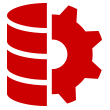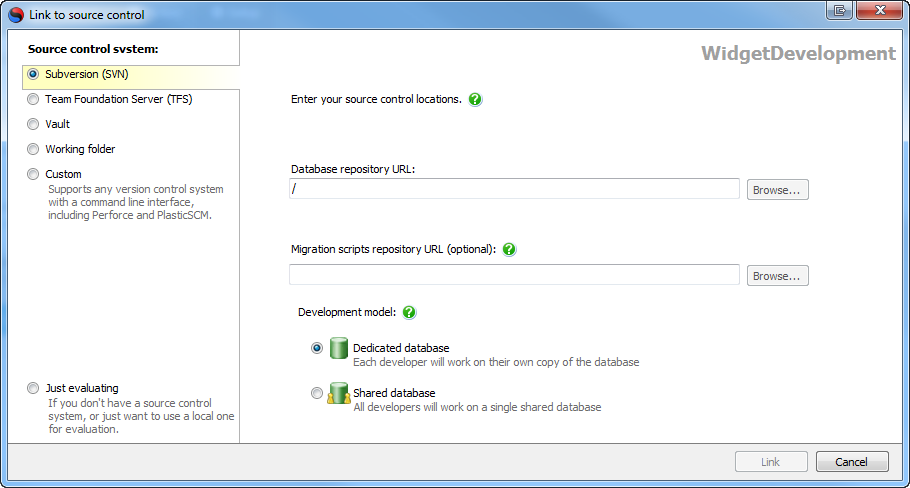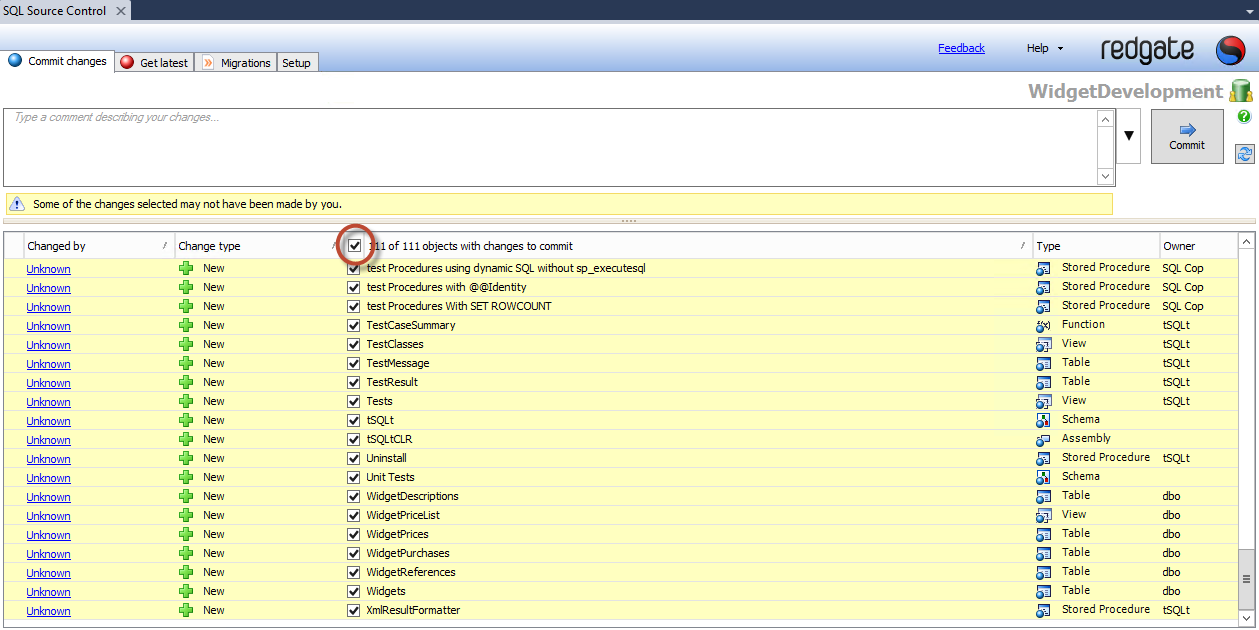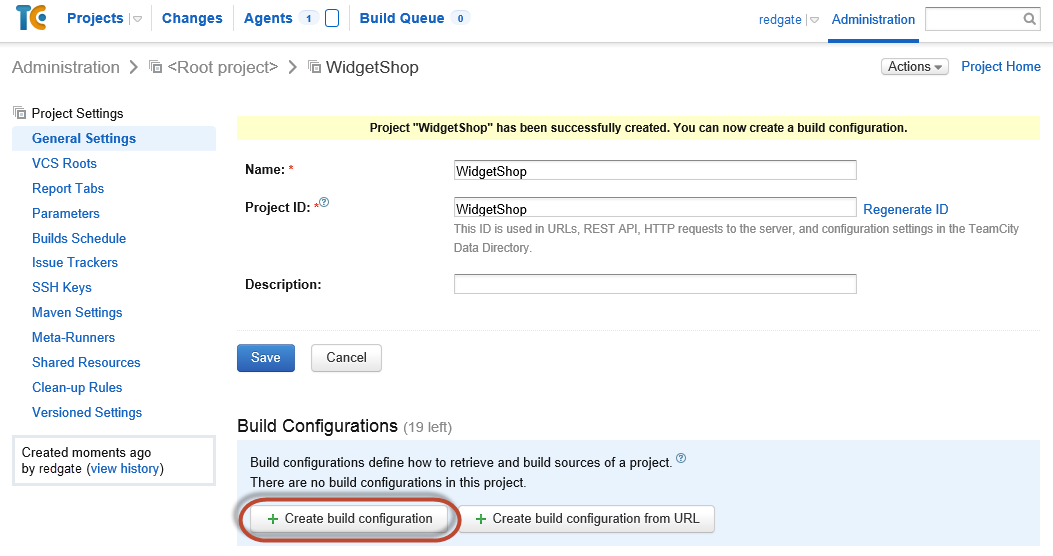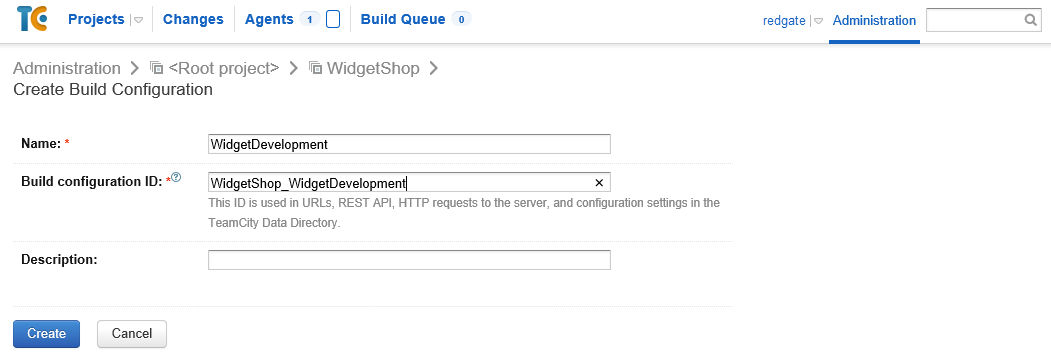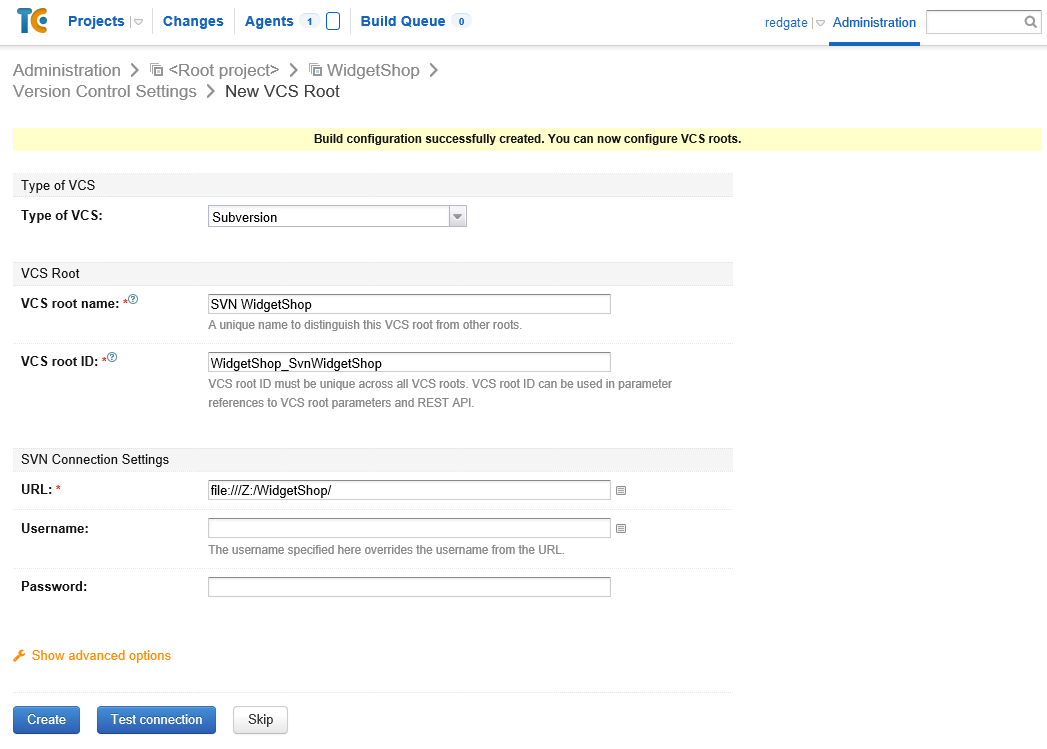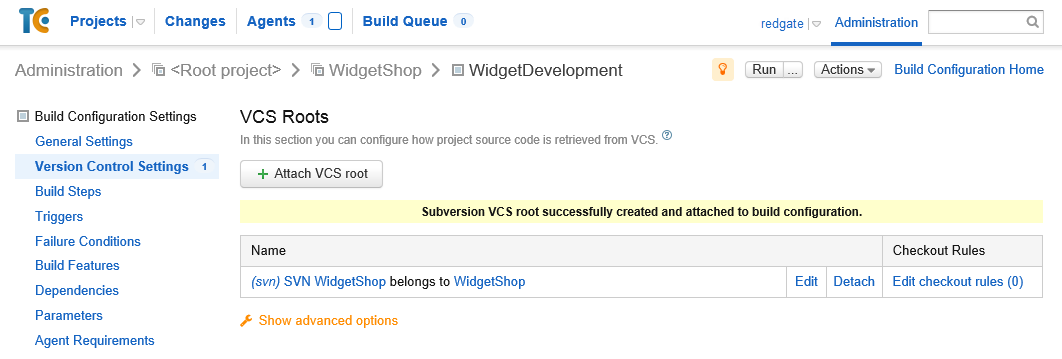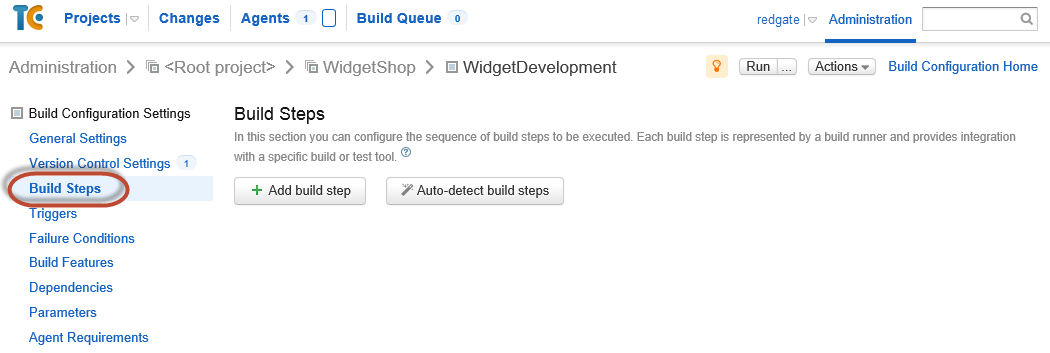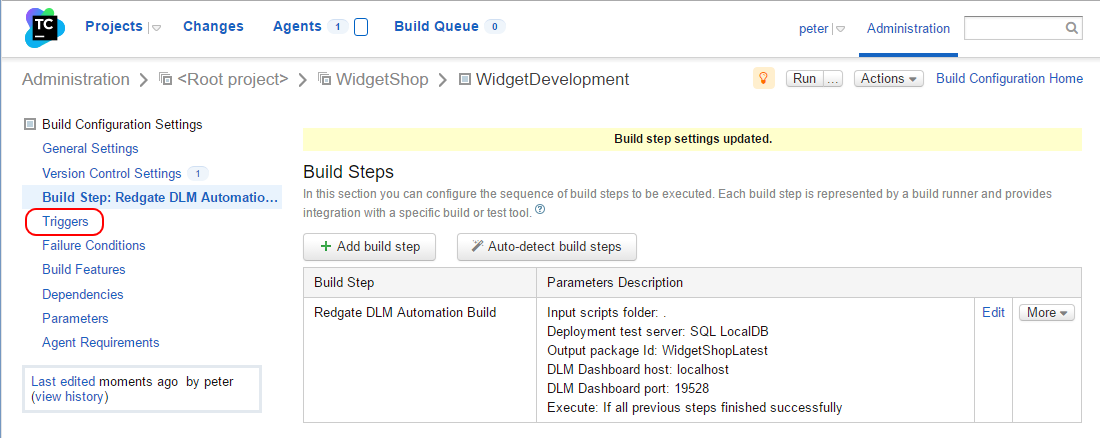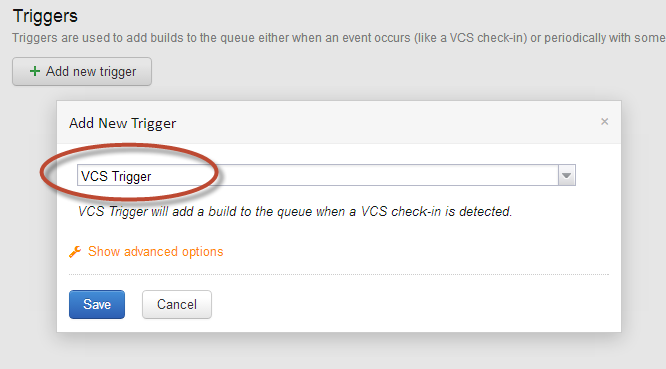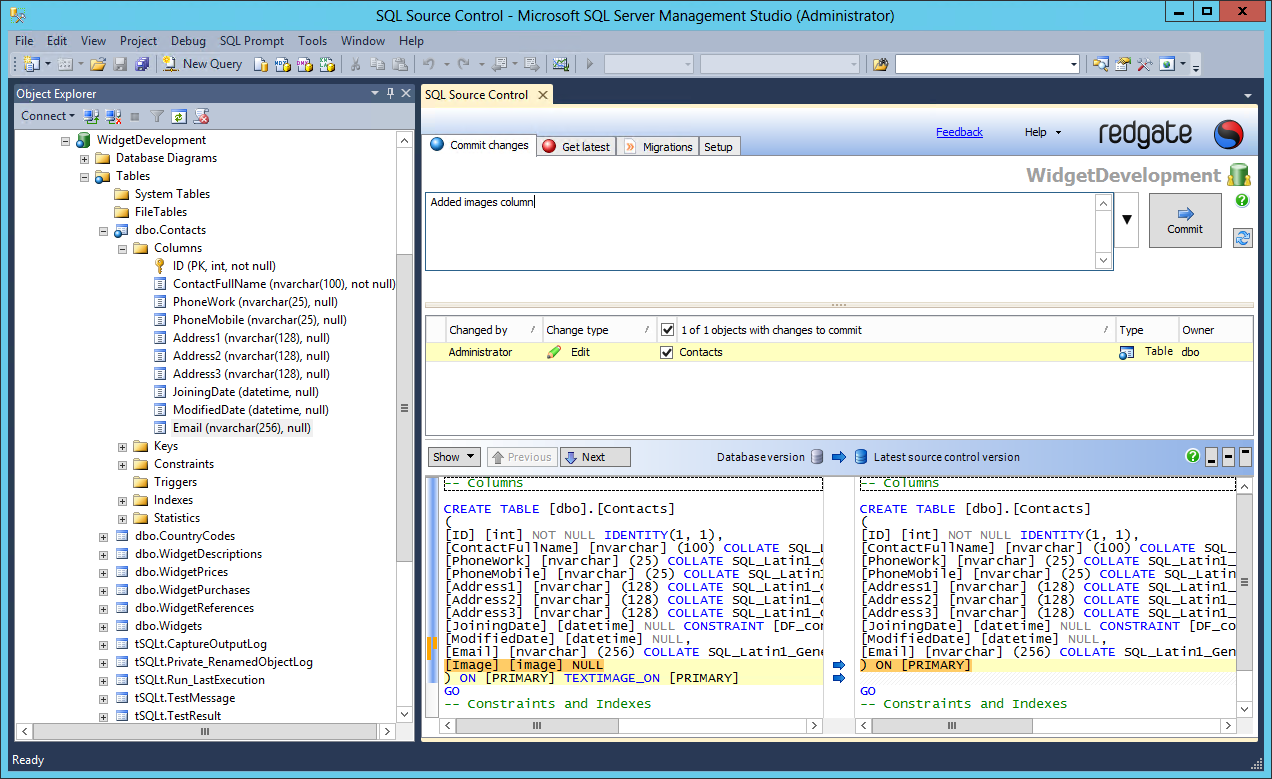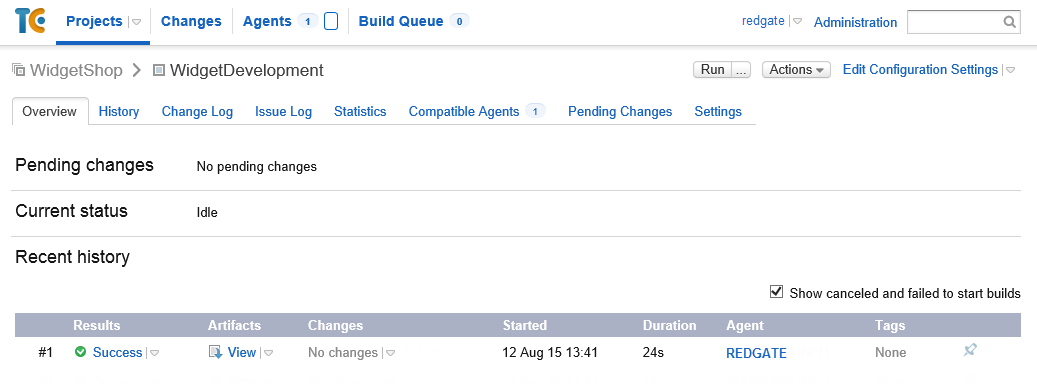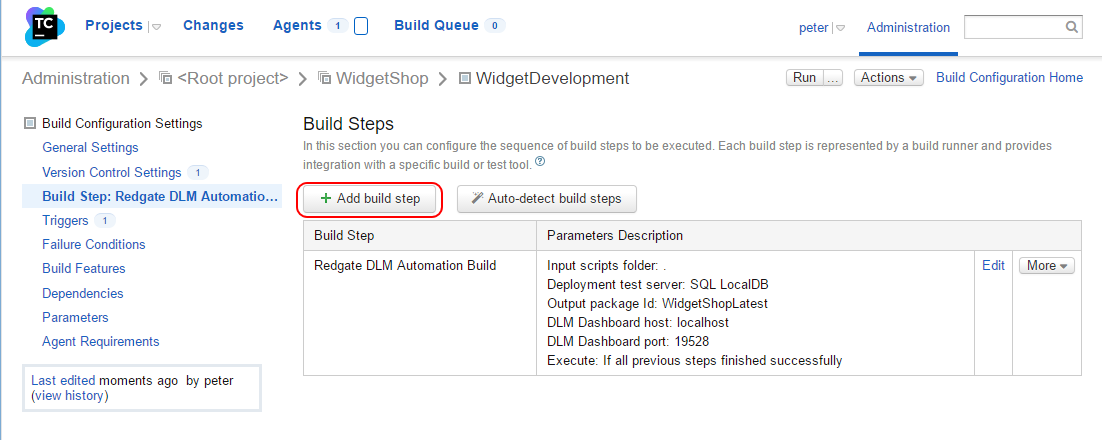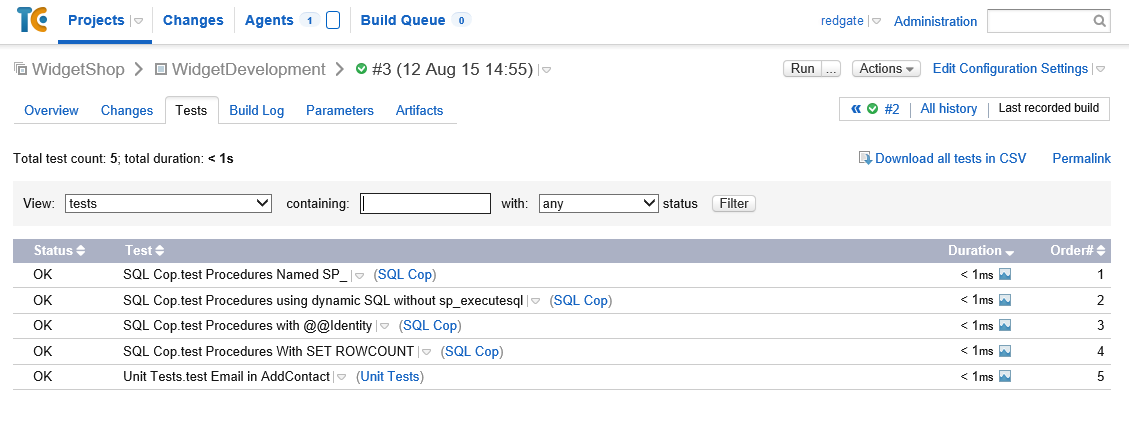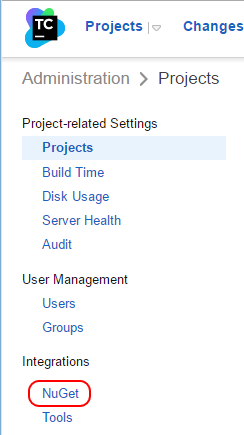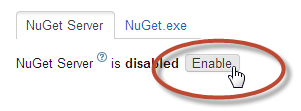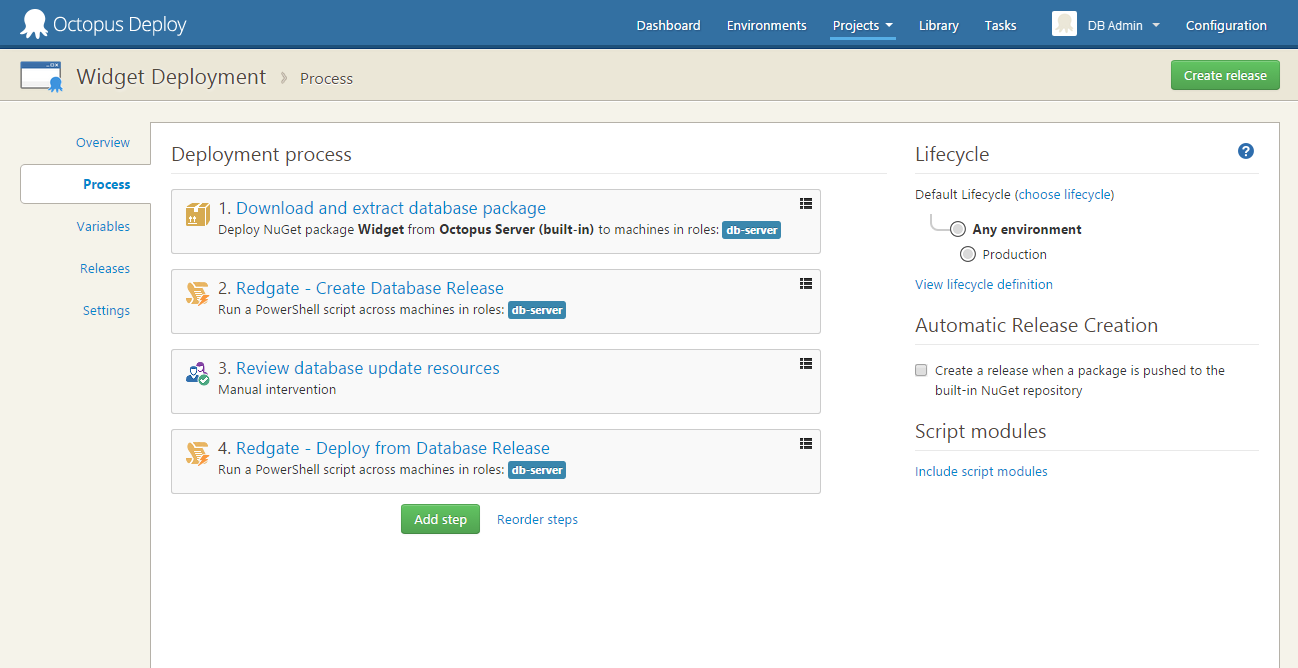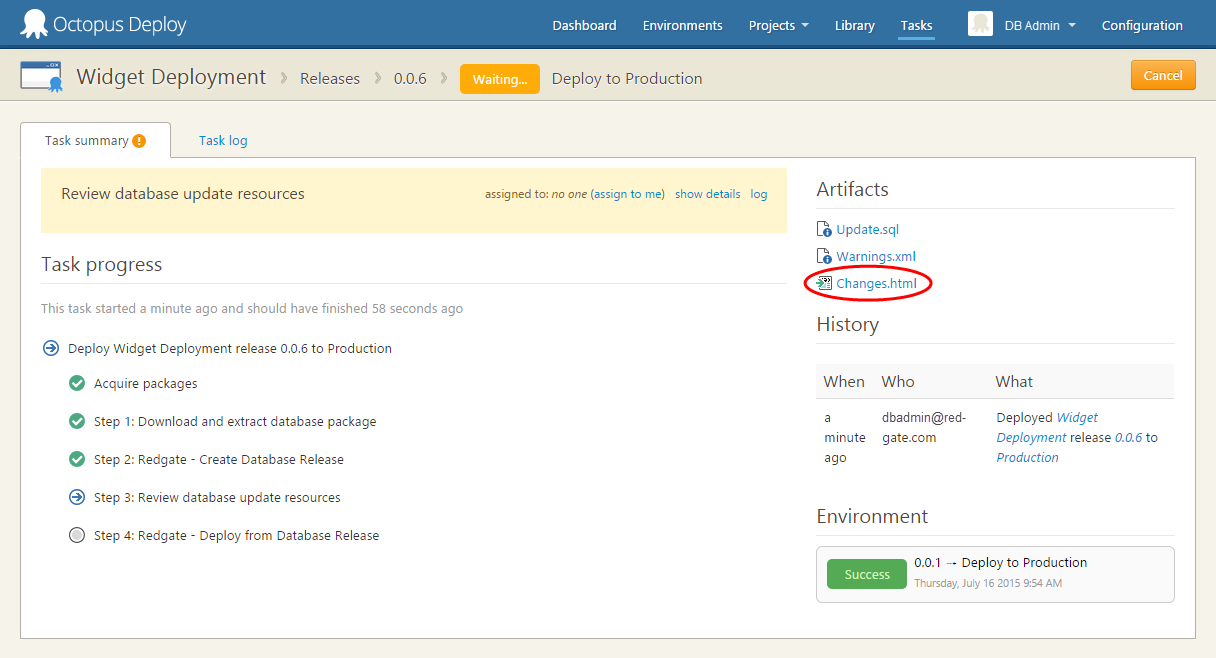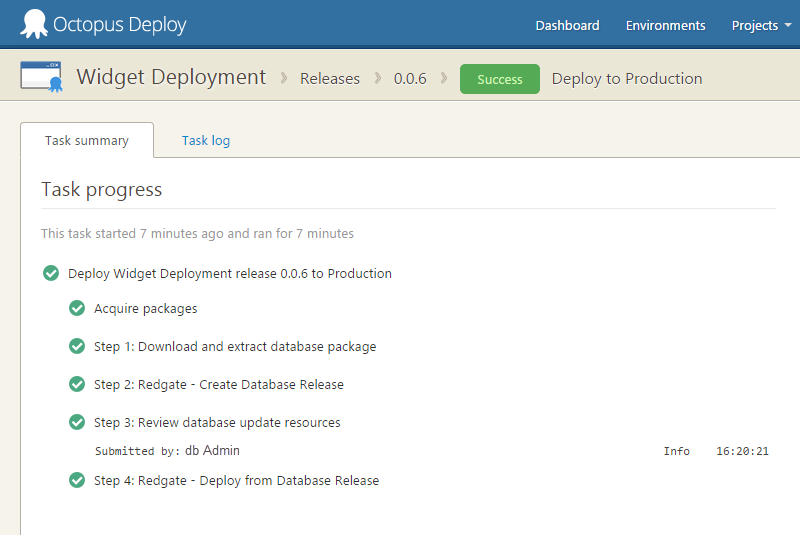Using the TeamCity plugin
Published 02 June 2016
In this example, you'll set up database lifecycle management using Redgate tools:
In this stage, you'll use SQL Source Control, Subversion (SVN) and TeamCity to:
- create the development database
- link the database to version control
- create a TeamCity project
- link the database to TeamCity
When you've finished, TeamCity will monitor every change you check into version control.
In this stage, you'll use TeamCity and DLM Automation's TeamCity plugin build runners to:
- build a database package
- test the package
- sync the package to a CI environment
- publish the package to a NuGet feed
When you've finished, TeamCity will automatically trigger a continuous integration process every time a change is checked into version control.
In this stage, you'll use Octopus Deploy and DLM Automation step templates to:
- create an Octopus Deploy project
- add a download and extract the package step
- add create, review and deploy steps
- create a release
When you've finished, you'll have set up an automated release process to deploy your database to production.
Before you start
We've described how to install tools on three different servers - development, build and deployment - which is a common configuration in the real world. If you can't do this, it's fine to install everything on one machine.
On your development server:
- Install SQL Server Management Studio (SSMS) version 2005 or later.
If you want to run tSQLt tests against the database, you'll also need access to a SQL Server 2012 instance with common language runtime (CLR) integration enabled. For more information, see Enabling CLR integration (MSDN article). - Install TortoiseSVN.
- Install Redgate SQL Source Control.
- Download the WidgetDevelopmentDatabaseCIDemo.zip file and extract the contents.
On your build server:
- Install JetBrains TeamCity version 7 or later. We've tested this example against version 9.1.1. This automatically installs a default build agent.
- From the Redgate DLM Automation add-ons page, download the DLM Automation TeamCity plugin and copy to the TeamCity data directory plugin folder. See Setting up the TeamCity plugin.
On your build agent:
- Install Redgate DLM Automation
On your deployment server:
- Install Redgate DLM Automation.
- Install Octopus Deploy and create a new environment called Production. See Install Octopus Deploy and create a new environment.
- Install an Octopus Tentacle and assign the db-server role. See Install an Octopus Tentacle.
Version control
In this section you'll:
- create the development database and use SQL Source Control to link it to version control
- create a TeamCity project and link the development database to it
Create the development database
Create the WidgetDevelopment database using the SQL script you extracted from the WidgetDevelopmentDatabaseCIDemo.zip file:
Open SQL Server Management Studio (SSMS).
- From the File menu, select Open > File.
- Browse to the WidgetDevelopment.sql file and click Open.
- Click Execute to create the WidgetDevelopment database.
Link the database to version control
Use SQL Source Control to link the WidgetDevelopment database to a shared Subversion (SVN) repository. You'll use the dedicated developer model, where each developer in your team will work on their own local copy of the database. For more information, see Database development models.
Use TortoiseSVN to create a Subversion repository. This must be a network folder that others in your team can access.
- Using Windows Explorer, create an empty folder for the repository, for example, Z:/WidgetShop
- Right-click the folder, and select TortoiseSVN > Create repository here.
Link the WidgetDevelopment database to Subversion using SQL Source Control:
- In SSMS Object Explorer, select the WidgetDevelopment database you want to link to source control.
- In SQL Source Control, on the Setup tab, make sure Link to my source control system is selected and click Link to source control:
The Link Database to Source Control dialog box opens:
- On the left under Source control system, select Subversion (SVN).
- In the Database repository URL field, specify the file:///Z:/WidgetShop/ folder you created in your SVN repository.
This is where SQL Source Control will save your SQL scripts. - Under Development model, select Dedicated database.
- Click Link.
The database is linked to source control. The database icon in the Object Explorer changes to show that the database is linked:
- Once the link to source control has been confirmed, click OK.
- To add the database objects to source control, click the Commit changes tab.
- We want to check in every object. Select the check box at the top of the list:
- Add a comment that describes the changes, for example, new database files added.
- Click Commit.
A progress dialog box is displayed while SQL Source Control commits the changes to your source control system. - Click OK to close the dialog box.
Source control is updated with your changes.
The SVN repository you've created is the shared directory that the team will use to check in code changes. Map it to the local folder that'll contain your working copy of the database. To do this:
- Right-click on your Desktop and select TortoiseSVN > Repo-browser.
- Paste the URL for the SVN repository, file:///Z:/WidgetShop/. Click OK.
- At the Repository Browser - TortoiseSVN dialog, in the left panel, right-click on the WidgetShop folder and select Checkout.
- In the Checkout directory field, enter your local working folder, for example C:\WidgetShop.
- Click OK. A local copy of the WidgetShop folder is created.
Create a TeamCity project
- In TeamCity Administration, under Projects, click Create project:
- On the Create New Project page, add WidgetShop as the name for the project.
The Project ID is created automatically: - Click Create.
- Under Build Configurations, click Create build configuration:
- On the Create Build Configuration page, add WidgetDevelopment as the build name:
- Click Create.
Link the database to TeamCity
Configure the TeamCity VCS settings so it knows which network folder to monitor for changes:
- On the VCS Roots page, from the Type of VCS drop-down list, select Subversion.
Under VCS Root Name and ID, in the VCS root name field, enter SVN WidgetShop as the unique name for this root.
Under SVN Connection Settings, in the URL field, enter file:///Z:/WidgetShop/.
This was the Database repository URL you entered when you linked the database to source control.
If authentication is required for your source control server, you must specify a username and password.
- Click Test connection. TeamCity checks that it can connect to the source control location.
Once the 'connection successful' message is displayed, close it and click Create.
The VCS settings are complete.
Continuous integration
These sections explain how to add automated steps to:
- build a package every time a change is checked into source control
- run tSQLt tests against the package
- sync the package to a CI environment
- publish the package to a NuGet feed
Build a package
In this section you'll use the DLM Automation TeamCity plugin to:
- add a build step to validate the SQL creation script and create a NuGet package
- add a VCS trigger to force a build every time a change is checked into version control
- trigger a build to test this step
Add a build step
You'll add the build step using one of Redgate's build runners for TeamCity.
A build runner allows a specific third party build tool, such as DLM Automation, to integrate with TeamCity. This example uses the DLM Automation Build runner that's part of Redgate's DLM Automation TeamCity plugin. It defines how to run the build and handle the output.
For more information on build runners, see Configuring Build Steps (JetBrains documentation).
When the build step validates the creation script, DLM Automation creates a temporary version of the database using LocalDB. This database is dropped once the build is complete.
- From the Build Configuration Settings menu, select Build Steps.
- Click Add build step:
- From the Runner type drop-down, select Redgate DLM Automation Build:
- Under Source-controlled database, leave the Database folder is my build VCS root option selected.
We've already configured the VCS root as our database location. Under Output package, at the Package ID field, enter WidgetShopLatest.
This is the name of the NuGet package you'll create. The name must be unique and can't contain spaces.When you're thinking of a package name to use in your own environment, remember that it's going to be deployed to other databases. A generic name that describes what you're deploying is better than one that's specific to the build step or the database itself. For example, if your database is called Development, this wouldn't make sense as a package name deployed to your production database.
Under Temporary database server, select SQL LocalDB.
DLM Automation uses LocalDB to recreate and validate a temporary version of your database. This database is dropped once the build is complete.If you're using Redgate's DLM Dashboard (version 1.4.4.313 or later), DLM Automation can send schema information to it every time the build step runs. Under DLM Dashboard integration:
- Enable the Send schema information to DLM Dashboard check box.
- Enter the name or IP address of the machine hosting the DLM Dashboard.
- Enter the DLM Dashboard port number. The default port is 19528.
Once you deploy changes (for example, by running the sync step), DLM Dashboard:
- recognizes the deployed schema from the information DLM Automation sent during the build step
- adds the schema to its list of recognized schemas, with the name <packageId-packageVersion>, for example, WidgetShop1.0
- labels the schema with the DLM Automation icon
- labels the schema as an update , not drift
For more information about how DLM Automation works with DLM Dashboard, see DLM Automation integration (DLM Dashboard documentation). For help understanding SQL Doc documentation, see What's in the documentation?
DLM Automation can include SQL Doc database documentation in the NuGet package that it builds. To select this option, under Database documentation, click Include database documentation.
Including database documentation will increase the size of the NuGet package and the time it takes to build, particularly for large databases.
The documentation is stored in db > docs > main.html in the NuGet package. If you're using DLM Dashboard version 1.6.3 or later and have set up DLM Dashboard integration, you can also view the documentation directly from DLM Dashboard. See DLM Automation integration (DLM Dashboard documentation).
- Click Save.
Add a VCS trigger
Add a trigger that'll force a build every time a change is checked into version control:
- From the Build Configuration Settings menu, select Triggers:
- On the Triggers page, click Add new trigger and select VCS Trigger from the drop-down:
- Click Save.
TeamCity will now run a build when you check in a change to your WidgetDevelopment database.
Trigger a build
Make a change to the WidgetDevelopment database to trigger a build automatically:
- Add a new Image column to the Contacts table:
- Use SQL Source Control to add a comment and commit the change:
Once the change is committed to source control, TeamCity picks up the change and runs a build. - To display the build status, click Projects:
- To show a summary of the log messages printed by the build, move your cursor over the Success drop-down button, and then click Build log.
To view the NuGet package, click Artifacts:
The build artifact is the name TeamCity gives to the output of a build step. In this example, the NuGet package is the artifact, and it's stored on TeamCity's server until we're ready to deploy it.
Test the package
In this section you'll:
- check a SQL Data Generator file into version control. This will generate meaningful test data for the database
- add a test step so that every time there's a new build of your database, DLM Automation will create a temporary version and run tSQLt tests against it
- trigger a build to test this step
The WidgetDevelopment database already has tSQLt installed. When you're setting this up in your own environment, you'll need to install it. For more information, see SQL Test.
Check the SQL Data Generator file into version control
We've provided a SQL Data Generator file that's already configured to generate data that's meaningful to the rows, columns and tables in the WidgetDevelopment database. You extracted this file from the WidgetDevelopmentDatabaseCIDemo.zip file.
Check the WidgetTestData.sqlgen file into SVN:
- Using Windows Explorer, copy the WidgetTestData.sqlgen file from WidgetDevelopmentDatabaseCIDemo > WidgetShop > Database to C:/WidgetShop
- Right-click on the WidgetTestData.sqlgen file and select TortoiseSVN > Add.
- Right-click again and select SVN Commit.
- At the Commit dialog, add a comment, for example, sqlgen file added. Click OK.
Add a test step
You can run different types of tSQLt tests, such as static analysis, unit or integration tests, against your temporary database.
The database schema for WidgetDevelopment already includes four basic SQL Cop tests that will run against the temporary database and check for:
- procedures named SP_
- procedures using dynamic SQL without sp_executesql
- procedures with @@Identity
- procedures with SET ROWCOUNT
There's also a unit test in the schema that checks email addresses in the Contacts column. Once the tests are complete, DLM Automation generates test reports for review. The temporary database is then dropped.
To create the test step:
- On the Build Steps page, click Add build step:
- From the Runner type drop-down, select Redgate DLM Automation Test.
- Under Output package, at the Package ID field, enter WidgetShopLatest.
This is the name of the NuGet package created by the build step. Under Temporary database server, select SQL LocalDB.
DLM Automation will use LocalDB to recreate the database for testing.- At the Run tests option, leave Run every test selected.
- At the Generate test data option, select the Populate the database with data before testing check box, and enter the path to the WidgetTestData.sqlgen file.
This must be relative to the VCS Root folder. In this example, the path is file:///Z:/WidgetShop/, so you just need to enter WidgetTestData.sqlgen. - Click Save.
Trigger a build
Make a change to the WidgetDevelopment database to trigger the build and test steps automatically:
- Check in a change to the WidgetDevelopment database.
- To display the build status, in TeamCity click Projects > WidgetShop.
Once the build step is complete, the test step starts automatically. - Once the steps are complete, click Tests passed: 5:
- Click the Tests tab.
Details of the completed SQL Cop tests and unit test are displayed:
To see more details about a specific test, or for troubleshooting a failed test, move your cursor over the drop-down button and select Show in build log.
Sync the package to a CI environment
Once your database has been through an initial test phase, it's good practice to run system, acceptance or smoke tests against it in an environment that simulates production. We'll called this the CI database, although it's sometimes called staging or preproduction.
In this section you'll:
- create a CI database
- add a sync step so that every time your database has been built and tested, DLM AUtomation will synchronize it to your CI database
- trigger a build to test this step
Create a CI database
Create a blank database called WidgetCI as your CI database:
- Open SQL Server Management Studio (SSMS).
- Click New Query.
Execute the following SQL query to create the WidgetCI database:
CREATE DATABASE WidgetCI GO USE WidgetCI GO
The database is now configured. It doesn't need to be checked into source control because it'll be updated automatically every time a change is made to the WidgetDevelopment database.
Add a sync step
Add a sync step in TeamCity:
- On the Build Steps page, click Add build step.
- From the Runner type drop-down, select Redgate DLM Automation Sync.
- Under Output package, at the Package ID text box, enter WidgetShopLatest.
- This is the name of the NuGet package you've already built and tested.
- Under Database server, enter the name of the target server and database you want to update. In this example, we're updating the WidgetCI database using Windows authentication.
- Click Save.
Trigger a build
Check in a change to the WidgetDevelopment database to trigger a build.
Once the build and test steps are complete, open SSMS to verify that the WidgetCI database has been synchronized with the contents of WidgetDevelopment:WidgetCI is in sync with WidgetDevelopment:
The WidgetCI database is now up to date with the latest version in source control. At this point, you could run additional tests against it.
Publish the package to a NuGet feed
Now that you've finished testing, you can publish the package to a NuGet feed. You can then use Octopus Deploy with DLM Automation to manage deployments.
We'll use TeamCity as a NuGet server to save you having to set up your own repository. For more details, see Using TeamCity as a NuGet Server (TeamCity documentation).
In this section you'll:
- enable the TeamCity NuGet server so you can publish the package to its NuGet feed
- trigger a build to test this step
If you're using a different release management tool, check the help documentation provided by that tool vendor.
Enable the TeamCity NuGet server
- In TeamCity Administration, under Integrations, click NuGet:
- On the NuGet Server tab, click Enable:
Trigger a build
Trigger a build to publish the package to the NuGet feed automatically.
Release management
Now you can deploy your database from the NuGet package to Octopus Deploy using DLM Automation.
The easiest way to do this is using DLM Automation step templates.
1. Copy the DLM Automation step templates to your Octopus Deploy library
Once you've copied the DLM Automation step templates to your Octopus Deploy library, they're available whenever you add a process step in an Octopus Deploy project:
- Go to the DLM Automation step templates on the Octopus Deploy library website.
- In this example, we'll use the "Redgate - Create Database Release" and "Redgate - Deploy from Database Release" step templates.
Click on the "Redgate - Create Database Release" template. - Click Copy to clipboard:
You're now ready to paste the script from your clipboard into your Octopus Deploy library:
- In Octopus Deploy, at the top of the page, click Library.
- On the Step templates tab, click Import.
- In the Import window, paste the copied template into the empty field.
- Click Import.
- Click Save.
- Repeat steps 1 to 5 to copy the "Redgate - Deploy from Database Release" step template in the same way.
2. Create an Octopus Deploy project
- In Octopus Deploy, click Projects and All.
- Click Add project.
- In the Name field, enter Widget Deployment.
- Click Save.
You'll now add a series of deployment process steps to your Octopus Deploy project.
3. Add the "Download and extract database package" step
This step picks up the NuGet package of the database schema you're going to deploy.
- Set up your NuGet package feed by doing one of the following:
- register your existing external NuGet package feed with Octopus. For more details, see Adding external package feeds.
- configure your build server to push packages to the Octopus built-in repository. For more details, see Using the built-in repository.
- In the Widget Deployment project, on the Process tab, click Add step and select Deploy a NuGet package.
- In the Step name field, enter Download and extract database package.
- In the Machine roles field, enter db-server and press Enter.
This must match the role you assigned to the Tentacle. - In the NuGet feed field, select either the name of the external feed you registered when you set up your NuGet feed, or the Octopus Server (built-in) repository.
- In the NuGet package ID field, enter the name of the package without the version number. For example, if the package was called WidgetShopLatest.0.1.nupkg, you'd only enter Widget.
When the package is generated, NuGet package manager automatically adds a number. If we included it here, Octopus would only deploy the package that matched that name and version number. By removing the number, we're telling Octopus to always look for the latest package with that name. - In the Environments field, select Production.
If you leave this blank, the step will be accessible to all environments. - Click Save.
4. Add the "Create database release" step
This step creates the database deployment resources, including the Update.sql script.
- On the project Process tab, click Add step and Redgate - Create Database Release.
- In the Machine roles field, enter db-server and press Enter.
This must match the role you assigned to the Tentacle. - In the Export path field, enter the path the database deployment resources will be exported to.
This path will later be used in the "Deploy from Database Release" step. It must be accessible to all tentacles used in database deployment steps. - In the Database package step field, select Download and extract database package.
- In the Target SQL Server instance field, enter the fully qualified SQL Server instance for the database you're deploying to.
- In the Target database name field, enter the name of the database you're deploying to.
- In the Username (optional) and Password (optional) fields, enter the SQL Server username and password used to connect to the target database.
If you leave these blank, Windows authentication will be used to connect to the target database. - In the Environments field, select Production.
If you leave this blank, the step will be accessible to all environments. - Click Save.
5. Add the "Review database deployment resources" step
This step pauses deployment to let you review the database deployment resources, including the Changes.html report, before allowing deployment to go ahead.
- On the project Process tab, click Add step and select Manual intervention required.
- In the Step name field, enter Review database deployment resources.
In the Instructions field, copy and paste this text:
Please review the schema and static data changes, warnings and SQL change script in 'Changes.html'.
In the Environments field, select Production.
If you leave this blank, the step will be accessible to all environments.Click Save.
6. Add the "Deploy from database release" step
This step uses the database deployment resources to deploy the database changes.
- On the project Process tab, click Add step and select Redgate - Deploy from Database Release.
- In the Machine roles field, enter db-server and press Enter.
This must match the role you assigned to the Tentacle. - In the Export path field, enter the path the database deployment resources will be exported to.
This must match the export path you entered in 4. Add the 'Create database release' step. - In the Database package step field, select Download and extract database package.
- In the Target SQL Server instance field, enter the fully qualified SQL Server instance for the database you're deploying to.
- In the Target database name field, enter the name of the database you're deploying to.
- In the Username (optional) and Password (optional) fields, enter the SQL Server username and password used to connect to the target database.
If you leave these blank, Windows authentication will be used to connect to the target database. - In the Environments field, select Production.
If you leave this blank, the step will be accessible to all environments. - Click Save.
You've finished setting up the project steps. The Process tab should look like this:
7. Create a release
Now all the steps are set up, you can run your deployment process to create a release:
- Create a blank database called WidgetProduction:
- Open SQL Server Management Studio (SSMS).
- Click New Query.
Execute the following SQL query to create a database:
CREATE DATABASE WidgetProduction GO USE WidgetProduction GO
- In the Widget Deployment project, on the Process tab, click Create release.
This page lets you add an optional release note. - Click Save.
- Click Deploy to Production (or if there's more than one environment, click Deploy and select Production).
- Click Deploy Now.
As the deployment process runs, Octopus Deploy shows the task progress list. The deployment pauses so you can review the database deployment resources: - Click Changes.html to download the Change report.
Use the report to review the update script, warnings, and details of what'll be added, removed or modified if you go ahead with deployment. - In Octopus Deploy, click assign to me and, in Notes, enter a comment to say you've reviewed the database deployment resources.
- If you're happy with the report, click Proceed.
When the deployment is complete, the Task progress page looks like this:
You've now completed the deployment of the database package.
What now?
Other DLM Automation step templates are available on the Octopus Deploy Library website:
- "Redgate - Deploy from Database" deploys the schema of a source database to a target database without a review step.
- "Redgate - Deploy from Package" deploys a NuGet package containing a database schema to a target database without a review step.
For more information, see Octopus Deploy step templates reference.
